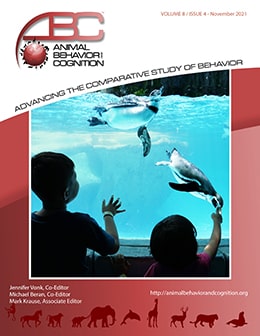Vol 8, Issue 4, November 2021
Animal-Visitor Interactions and the Visitor Experience: Visitor Behaviors, Attitudes, Perceptions, and Learning in the Modern Zoo
Citation
Learmonth, M. J., Chiew, S. J., Godinez, A., & Fernandez, E. J. (2021). Animal-visitor interactions and the visitor experience: Visitor behaviors, attitudes, perceptions, and learning in the modern zoo. Animal Behavior and Cognition, 8(4), 632-649. https://doi.org/10.26451/abc.08.04.13.2021
Abstract
Animal-Visitor Interactions (AVIs) have become commonplace in zoological institutions and facilities globally. However, most AVI research focuses on the effects of visitors on the welfare of animals, with considerably fewer studies examining the visitor experience itself. Furthermore, robust evaluations of the efficacy of zoo education programs and engagements for increasing visitor awareness of conservation issues, and for fostering long-term pro-conservation behavior changes in them, are under-researched. This paper reviews the current literature that pertains to the effects of zoo visitation and AVIs on visitor perceptions, beliefs, and attitudes. We briefly note some of the known effects that zoo visitors have on zoo animals, then explore the effects that factors such as enclosure design, animal visibility and behaviors, and AVIs can have on visitors’ overall experience whilst attending the zoo. We suggest that future research needs to more closely examine the relationships and interactions between zoo visitors and zoo animals; why some zoo visitors over others repeat visitation; what the differences in beliefs and attitudes may be between “zoo visitors” and “non-zoo visitors” (i.e., other general public); and to make a concerted effort to understand: (1) what visitors do after they leave the zoo, and (2) whether visitors adopt long-term pro-conservation behaviors into their daily lives. We further suggest that future research needs to start investigating indirect measures related to the visitor experience, such as: (a) individual conservation support outside of the zoo; (b) internet activity; (c) changes in sustainable purchasing practices related to knowledge gains; (d) financial investment in sustainable or ethical companies after knowledge gains; (e) and the longitudinal effects of zoo visits.
Keywords
Animal-visitor interactions, Human-animal interactions, Visitor attitudes, Visitor behaviors, Visitor experience, Visitor learning, Visitor perceptions
